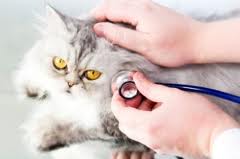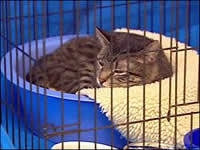Just like humans, cats occasionally need to visit the doctor, too. The experience doesn't have to be traumatic! There are some things you can do to make the trip pleasant for everyone.
Taking Your Cat to the Veterinarian
Imagine how you would feel if someone suddenly picked you up, put you in a box, took you for a ride in strange vehicle, and then let an unknown person in a white coat probe your most delicate areas and stick needles in you! That is what the experience of going to the veterinarian seems like to cats. There are steps you can take to make this a less frightening experience for your cat.
Get your cat used to her cat carrier well before her veterinary appointment. Leave the open carrier sitting out so that she can explore it on her own. Place catnip or treats in the carrier to get her to look inside. You can even leave the carrier out permanently as a bed or hiding place for the cat (see Free Access Crate Training).
Get the cat used to going for rides in the carrier. Put her into the carrier with a special treat and drive around the block a few times. The cat will be less fearful if she sees that a ride in the carrier does not always end at the vet's office. She will also get more accustomed to riding in the car. When the cat is riding in your car, turn the stereo down to a low volume, roll up the windows and turn on the air vents. Too much noise from the stereo or the road can frighten the cat. Never put your cat into a hot car or leave her there unattended for any length of time!
Attempt to make the trip to the vet a positive experience. Give the cat special treats or toys at the vet's office. Schedule appointments at the least busy time of day and call ahead to make sure the vet is running on time. Sitting in a crowded waiting room with barking dogs and crying children will only create more anxiety for your cat. If your cat is very fearful of dogs you can go to a clinic that only sees cats.
When you bring the cat home, make sure that the cat's refuge is available. Cats recognize one another by smell. When your cat returns home, other cats may treat her as an outsider because she smells like the vet's office. You may need to slowly reintroduce her to avoid conflict (see Introducing a New Cat).
In an emergency you may need to take the cat to the vet without the opportunity to prepare her. In this case you can wrap her in a towel and place her in the carrier.
When Your Cat is Hospitalized
If your cat needs to be hospitalized, visit her as often as the clinic allows. Make sure the cat has a refuge available when she comes home. Cats recognize one another by scent. When your cat returns home, other cats may treat her as an outsider because she smells like the hospital. You may need to slowly reintroduce her to avoid conflict (see Introducing a New Cat).
When Your Cat is Sick or Recovering at Home
If your cat is not feeling well you should always consult your veterinarian. For minor illnesses the veterinarian may prescribe medicine and treatments to be given at home. Alternatively the cat may be returning home to recover after being hospitalized. The cat will need to rest quietly at home. Provide her with a refuge and don't allow other pets into that room. Make sure that human family members also respect the privacy of the refuge.
One person should be assigned as the primary caregiver for the cat while she is sick. That person should spend quiet time with the cat. Don't try to handle her too much unless she is receptive. Carefully follow the veterinarian's instructions for administering medicine. Be gentle with the cat when medicating her and give her treats and praise to help make it a positive experience. If your cat is not good at taking medicine, ask the veterinarian about compounding the medicine with a flavored base such as fish or chicken.


